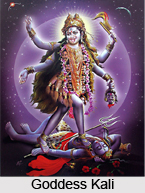 Later History of Goddess Kali emphasizes the significance of the Goddess in attaining salvation. Goddess Kali dominates Tantric iconography. Kali is considered as the highest reality. According to Nirvana Tantra Lord Brahma, Lord Vishnu and Lord Shiva rise from her. According to Nigama Kalpataru and Picchila Tantra, the mantras of Goddess Kali are the greatest. In Yogini Tantra and Kamakhya Tantra and the Nirutta Tantra consider Kali as the greatest of the divinity. She is declared as the essence. According to Kamada Tantra she has no attributes. In Mahanirvana Tantra also she is a common epithet for Shakti.
Later History of Goddess Kali emphasizes the significance of the Goddess in attaining salvation. Goddess Kali dominates Tantric iconography. Kali is considered as the highest reality. According to Nirvana Tantra Lord Brahma, Lord Vishnu and Lord Shiva rise from her. According to Nigama Kalpataru and Picchila Tantra, the mantras of Goddess Kali are the greatest. In Yogini Tantra and Kamakhya Tantra and the Nirutta Tantra consider Kali as the greatest of the divinity. She is declared as the essence. According to Kamada Tantra she has no attributes. In Mahanirvana Tantra also she is a common epithet for Shakti.
Tantrism is ritual oriented. Kali`s image depicts death, fear, terror. She is the all consuming aspect of reality. During the ritual of Panchatattva, sadhaka controls Kali thereby transforming her into a medium of salvation. This is also described in Karpuradi stotra which is a short work eulogizing Goddess Kali. Here the panchatattva ritual is also described that is performed on the cremation ground. It is she when confronted in meditation who gives the sadhaka immense power thereby giving ultimate salvation. Sadhaka meditates on every aspect of Kali in order to achieve the goal.
In Karpuradi stotra she is considered as the supreme mistress of the creation. She is identified with five elements. In unison with Lord Shiva she destroys and creates the world. There are places where she is considered as benign. For instance in Karpuradi stotra she is young and beautiful. She is someone through whom the hero achieves success by granting boon of salvation. Here she is the symbol of death as well as symbol of triumph over death.
Shiva`s involvement with Tantra and Kali`s dark nature have made her an important Tantric figure. The tantric worshippers need to face her curse, the terror of death, as they accept blessings from her maternal aspect. She has been given great metaphysical significance by some texts of Tantra. The final stage is the worshipping of Kali as the Great Mother devoid of violence. She is considered as Devi of delusion, Mahamaya, acting in the confines of the nature of the three gunas. She takes three forms: Maha-Kali, Maha-Lakshmi and Maha-Saraswati, being her tamas-ika, rajas-ika and sattva-ika forms.









